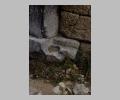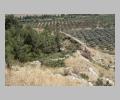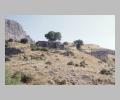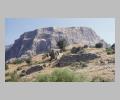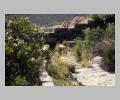| Context: | Priene |
| Type: | Fortification |
| Summary: | Well-preserved fortification wall circuit with towers, enclosing the site and the acropolis hill in the north. |
| Date: | ca. 350 BC - ca. 340 BC |
| Dimensions: | Highest preserved section of wall ca. 8.00 m. Average thickness of walls 2.00 m. Width of West Gate 2.69 m. Width of South-East Gate 2.40 m. |
| Region: | Ionia |
| Period: | Late Clas./Hell. |
Plan:
In plan, the walls are of saw-tooth design, with square towers at intervals. The majority of the towers are solid, but there are hollow, two-storied towers which served as barracks for the guards. The wall includes in its circuit three city gates, the East Gate, West Gate, and South-East Gate. The East Gate, the main entrance to the city, was vaulted with a limestone arch and was reached from the outside by a long, paved ramp. Two curving walls inside the gate created a horseshoe-shaped court within which an attacking force would be trapped. The West Gate was also arched; no towers protected this gate, but the steep topography provided adequate defense. The South-East Gate was protected by a tower from which a defending force could fire on the enemy's unprotected right flank. In two locations in the lower city wall, and once on the acropolis, staircases are preserved which led to a defensive walkway.
Date Description:
Letter forms of original inscription built into niche in South-East Gate; plan of fortifications and use of saw-toothed type; assumption that fortifications would have been one of the first elements constructed.
History:
The construction of the fortifications at Priene is contemporary with the new foundation of the city in ca. 350 B.C.
Other Notes:
Built into the west facade of the South-East Gate is an inscription, contemporary with the construction of the wall, preserving the following text:
"When asleep, Philios Kyprios (of Cyprus?) of the Exalaminos family (?), son of Ariston of (?) Naolochos, saw in a dream holy reverend Thesmophoroi in white cloaks. And in three visions they ordered him to honor this hero of the guard of the city and they showed him the spot. Wherefore Philios established this sanctuary." The use of the saw-tooth wall design, combined with the contours of the land, would have compelled an attacking force to concentrate their attack on the projecting towers. The saw-tooth wall design is referred to by
Other Bibliography:
